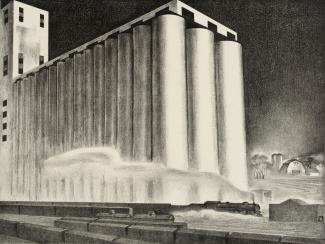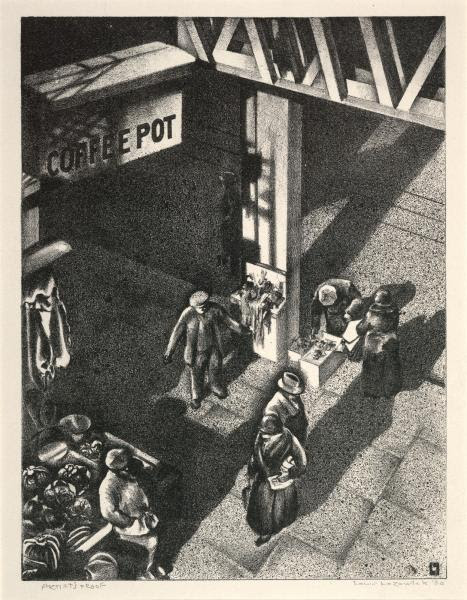TUESDAY, JULY 21 LOUIS LOZOWICK CONTINUED


Tuesday, July 21th, 2020
Our 110th Edition
MORE TREATS FROM THE PAST
LOUIS LOZOWICK
ARTIST
IMAGINING CITIES
PART 2 of 2
THESE ARE A SMALL SAMPLING OF LOZOWICK’S WORK ON VIEW AT THE SMITHSONIAN WEBSITE.
Louis Lozowick
(1892 – 1973)
was a Russian-American painter and printmaker. He is recognized as an Art Deco and Precisionist artist, and mainly produced streamline, urban-inspired monochromatic lithographs in a career that spanned 50 years.

Lithograph on Paper

1938
COLOR LITHOGRAPH ON PAPER

1938
LITHOGRAPH ON PAPER

CITY ON A ROCK-COHOES
1931
LITHOGRAPH ON PAPER

FOOD AUGUST
1943
LITHOGRAPH ON PAPER

WARSAW MARKETS
1937
LITHOGRAPH ON PAPER

COLLLECTIVE FARMER
1933
LITHOGRAPH ON PAPER

THANKSGIVING DINNER
1932
LITHOGRAPH ON PAPER

MINNEAPOLIS
1925
COLOR WOODCUT ON PAPER

1934
LITHOGRAPH ON PAPER

1972
LITHOGRAPH ON PAPER

1939
LITHOGRAPH ON PAPER

1955
LITHOGRAPH ON PAPER

1959
LITHOGRAPH ON PAPER

1940
COLOR WOODCUT ON PAPER

1923
LITHOGRAPH ON PAPER

Learn more about Lozowick and his work
Meet Louis Lozowick Through His Geometric Work “Red Circle”
By Beth Hamilton
Louis Lozowick was born in 1892 in Ludvinovka, Ukraine, then part of the Russian empire. Lozowick’s interest in art began in 1903 when he enrolled in the Kiev Art School. This early education was a formative experience for Lozowick; he would spend the rest of his career pursuing art studies.
Seeking greater civil and economic liberties, Lozowick followed his brother to New York in 1906. Lozowick arrived at Ellis Island alone, and was stunned by the modern developments of the growing metropolis. New York was unlike anything he had seen during his rural upbringing in Russia, with the vertical architecture and industrialized economy. From 1912 to 1915, Lozowick attended the prestigious National Academy of Design in New York. He studied under Ivan Olinsky, Emil Carlsen, Douglas Volk, George W. Maynard, and Leon Kroll. The curriculum was largely academic in tradition, a style that he felt did not accurately portray the modern city. In 1915, Lozowick began his college studies at Ohio State University, where he graduated in three short years.
He served briefly in the army in 1919 with the U.S. participation in World War I. Immediately after his discharge, Lozowick embarked on a cross-country trip, visiting major industrial cities of the United States. The visual landscape of these cities, filled with smokestacks, factories, skyscrapers, and the expanding network of highways, informed his style in the years to follow.
In 1922, Lozowick traveled to Europe like many like-minded artists seeking avant-garde movements. He first went to Paris, where he studied French at the Sorbonne Institute and surveyed the Cubist masterpieces of Juan Gris and Fernand Léger. He then went to Berlin, a city vibrant with artists and intellectuals. Lozowick was drawn in particular to the Russian Constructivists, who championed the machine aesthetic through abstraction and minimalism. His art career took off in this experimental environment, as he was inspired by the works of El Lissitsky and Kazimir Malevich.
Louis Lozowick, American, 1892-1973. Red Circle, 1924. Oil on canvasboard. 18 x 15 inches. Signed on the reverse

Drawing from the vivid memories of his cross-country trip, Lozowick created his American Cities series while still in Berlin. The fourteen paintings in this series depict Pittsburgh, Detroit, New York, Seattle, Minneapolis, Butte, Cleveland, and Chicago. Red Circle is part of the series, although its title does not suggest a specific location.
The works are Precisionist in style and composition; simple shapes are rendered with precise and sharp clarity, depicting common subjects from the American landscape. Monumental and soaring structures were at the forefront of this series and many of his works during the 1920s.
Red Circle is a series of overlapping architectural forms and geometric shapes. The repeated window patterns on the starkly linear buildings suggest a landscape of factories; the cylindrical forms at center represent the smoke stacks adjacent to an industrial facility. The grey palette of the composition is further heightened by the dark shadows cast by the buildings from an unidentified light source. Four fractured, red circles overlap with the buildings.
Lozowick’s predilection for Constructivist design principles is evident in Red Circle, although his influence is purely aesthetic. The primary color palette of red, black, grey, and white is symbolic of the Russian revolution and was often used by the Russian avant-gardes. Lozowick incorporated these artistic principles in poster designs, stage sets, and win- dow displays in addition to his painting.
Lozowick continued to paint skyscrapers, factories, and machine parts during the 1920s with an optimistic vigor shared by many artists. After his return to New York, Lozowick exhibited his Cities and Machine Ornament works at J.B. Neumann’s New Art Circle in 1926. That same year, he had a two-man show at New Art Circle with the Precisionist artist Charles Sheeler. With the economic crash in 1929, images of urban growth and industrial progress were no longer relevant. Lozowick then began to experiment in realism, with the human figure central to the composition.
TUESDAY PHOTO OF THE DAY
IDENTIFY THIS ART PIECE
SEND ENTRY TO ROOSEVELTISLANDHISTORY@GMAIL.COM
WIN A KIOSK TRINKET

MONDAY PHOTO
NEW BRANCH
NYPL AT 504 MAIN STREET

EDITORIAL
I have seen some of Louis Lozowick’s art throughout many years. When I discovered that the Smithsonian had 241 of his works on-line, I was thrilled. This is a small selection of the works. The rest are available at:
https://americanart.si.edu/artist/louis-lozowick-3005
THANK YOU SMITHSONIAN FOR SHARING OUR NATIONAL TREASURES WITH US!!!
I will continue to seek out artists of the early to mid-twentieth century art. If you have a suggestion, contact me.
Judith Berdy
Text by Judith Berdy Thanks to Bobbie Slonevsky
for her dedication to Blackwell’s Almanac
Thanks to Deborah Dorff for maintaining our website
Edited by Melanie Colter and Deborah Dorff
All materials in this publication are copyrighted (c)
ALL IMAGES ARE ON VIEW AT THE SMITHSONIAN WEBSITE
https://americanart.si.edu/artist/louis-lozowick-3005
IMAGES AND TEXT COURTESY OF JONATHON BOOS FINE ART
MATERIAL COPYRIGHT WIKIPEDIA, GOOGLE IMAGES, RIHS ARCHIVES AND MAY NOT BE REPRODUCED WITHOUT PERMISSION (C)
FUNDING BY ROOSEVELT ISLAND OPERATING CORPORATION PUBLIC PURPOSE FUNDING
DISCRETIONARY FUNDING BY COUNCIL MEMBER BEN KALLOS THRU NYC DYCD


Copyright © 2020 Roosevelt Island Historical Society, All rights reserved.Our mailing address is:
rooseveltislandhistory@gmail.com

Leave a comment